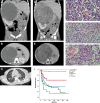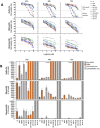Amplification of CDK4 and MDM2: a detailed study of a high-risk neuroblastoma subgroup
- PMID: 35859155
- PMCID: PMC9300649
- DOI: 10.1038/s41598-022-16455-1
Amplification of CDK4 and MDM2: a detailed study of a high-risk neuroblastoma subgroup
Abstract
In neuroblastoma, MYCN amplification and 11q-deletion are important, although incomplete, markers of high-risk disease. It is therefore relevant to characterize additional alterations that can function as prognostic and/or predictive markers. Using SNP-microarrays, a group of neuroblastoma patients showing amplification of one or multiple 12q loci was identified. Two loci containing CDK4 and MDM2 were commonly co-amplified, although amplification of either locus in the absence of the other was observed. Pharmacological inhibition of CDK4/6 with ribociclib or abemaciclib decreased proliferation in a broad set of neuroblastoma cell lines, including CDK4/MDM2-amplified, whereas MDM2 inhibition by Nutlin-3a was only effective in p53wild-type cells. Combined CDK4/MDM2 targeting had an additive effect in p53wild-type cell lines, while no or negative additive effect was observed in p53mutated cells. Most 12q-amplified primary tumors were of abdominal origin, including those of intrarenal origin initially suspected of being Wilms' tumor. An atypical metastatic pattern was also observed with low degree of bone marrow involvement, favoring other sites such as the lungs. Here we present detailed biological data of an aggressive neuroblastoma subgroup hallmarked by 12q amplification and atypical clinical presentation for which our in vitro studies indicate that CDK4 and/or MDM2 inhibition also could be beneficial.
© 2022. The Author(s).
Conflict of interest statement
The authors declare no competing interests.
Figures






References
Publication types
MeSH terms
Substances
LinkOut - more resources
Full Text Sources
Other Literature Sources
Medical
Research Materials
Miscellaneous

